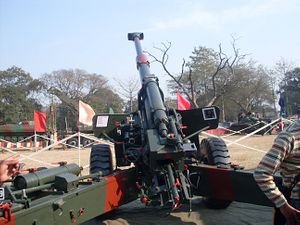India’s new indigenously designed and developed Dhanush 155-millimeter/45-caliber towed howitzer is ready for induction following the completion of final development trials at the Indian military’s test range at Pokhran in the Thar Desert region in northwestern India, according to a senior defense industry official.
Six Dhanush guns were tested from June 2 to 6 firing fifty rounds each, Gun Carriage Factory (GCF) Senior General Manager SK Singh said on June 8. “Six guns in battery formation (at one go and at one target) successfully fired 101 rounds on June 7,” he was quoted as saying by the Press Trust of India (PTI).
The artillery gun is now ready for induction, Singh claims. The Dhanush is an improved version of the FH-77B 155-millimeter/39 caliber towed howitzer manufactured by the Swedish defense contractor Bofors (now BAE Systems) of which India acquired 414 between 1987 and 1991.
“[T]he major upgrade in comparison to the Bofors is the larger caliber,” I wrote elsewhere. “Furthermore, the Dhanush reportedly has a new maximum effective range of 38 kilometer in salvo mode compared to the 39-caliber, 27-km range of the original guns. The Dhanush howitzer is capable of firing eight rounds per minutes and needs a crew of six to eight artillerymen.”
An upgraded variant of the Dhanush gun, designated Dhanush Version 2 (v2) with a larger caliber (from 45 to 52 millimeter) and a slightly increased range (from 38 to 42 kilometers), is currently under development by India’s Defense Research and Development Organization.
The Dhanush howitzer is based on schematics supplied by Bofors/BAE Systems under a technology transfer deal inked in the late 1980s. Both versions of the Dhanush howitzer are essentially reverse-engineered improved variants of the original Bofors design. 81 percent of the Dhanush’s components are indigenously sourced, according to Singh, which is slated to increase to 90 percent by the end of 2019.
“[T]he initial procurement of the Bofors howitzers in the 1980s was steeped in controversy and led to India’s most infamous arms purchase scandal in recent history, which torpedoed all artillery modernization plans,” I noted previously. Bofors allegedly paid illegal kickbacks in exchange for the defense deal, with the result that the company was blacklisted by the Indian government.
Over the past few months, the Dhanush gun has successfully completed a number of tests including cold, hot, and humid weather trials. Last year, the gun failed twice during user trials when a shell of the gun hit the muzzle brake on two separate occasions. However, an inquiry by the Indian Ministry of Defense did not find any fault with the guns and attributed the failures to defective shells.
The Indian Army has placed an initial order for 114 Dhanush howitzers, with the first batch of guns to be manufactured at the GCF in Jabalpur district of Madhya Pradesh in central India and expected to be handed over to the service by the end of the current fiscal year. However, no official contract has been concluded so far.
The Indian Army is reportedly interested in procuring up to 414 Dhanush howitzers for a per-unit price of a little over $2 million. In April of this year, the Ordnance Factory Board for the first time also revealed a new variant of the road-mobile Mounted Gun System armed with the Dhanush howitzer.
































